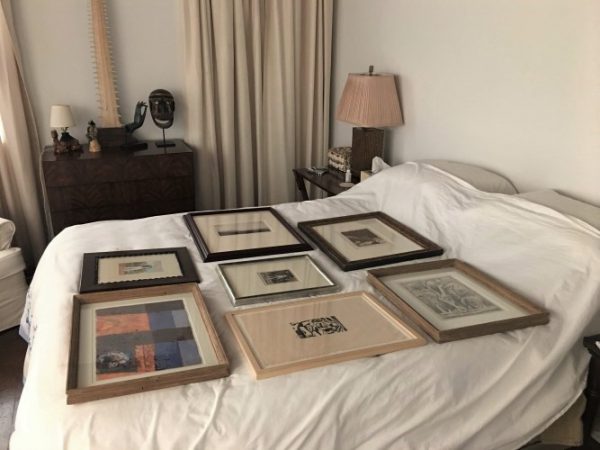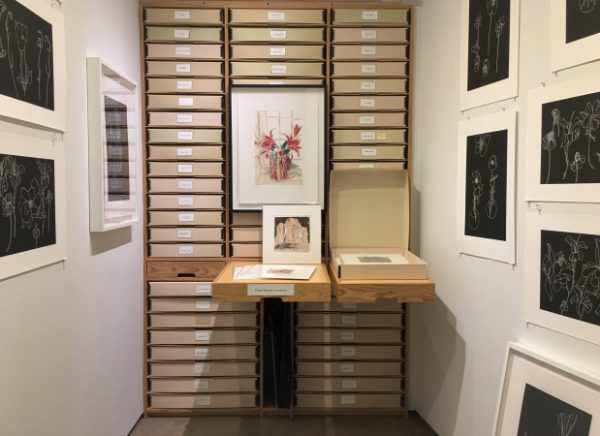Most Fine Art Insurance professionals will agree that the best way to ensure that an insured loss is settled quickly and fairly is by properly documenting your art collection. Being able to easily provide your insurance carrier with images, acquisition paperwork, and provenance information is only one of many reasons to keep detailed collection records. For instance, your bill of sale will not just prove ownership, if the artwork is sold, combined with a canceled check or a credit card receipt it can prove to the IRS what you originally paid. But for this post, rather than expound on which records are important to keep and why, I have focused on the reasons to digitize all of them, suggested ways to implement the digitization process, and recommend strategies to mitigate the possibility of data loss through thoughtful backups.
To be sure that any appreciation is covered, most collectors opt to have a blanket, as opposed to a scheduled policy protecting their art. Let’s say you have a collection of 100 artworks you believe to be worth $1,000,000, and you decide to take out a blanket policy for $500,000, opting to self-insure any loss beyond that amount. If you have a covered loss of an artwork, you will need to provide the adjustor with documentation proving ownership and its value when the incident took place. And, if theft was involved, you will probably be asked to provide a police report.
Providing Proof:
Proving you possessed an artwork can be as easy as having a photograph of it on the wall of your home and a related bill of sale. If you carry a blanket policy and have a covered loss, it is likely that your insurance agent will have no information about the work in question beforehand. Proof of the works existence, ownership, and that the loss actually occurred is on you. The determination of value will most likely have to be through a professional appraisal after the loss using the documentation you provide, so it needs to be thorough and convincing.

Also, you may have excellent files documenting each artwork you own, but if it is all kept in the same location, everything could be lost in the same event. In my insurance post, I recounted a story my homeowners agent told me about the damage inflicted by an F5 tornado she was adjusting in southern Oklahoma City. She said that she literally cried with those who had lost their homes because many had no proof they had any contents. All of their possessions had been blended with their neighbor’s, and scattered over many blocks along with the photographs, files, and receipts that would have proven ownership. This type of total loss is one of the reasons most insurance companies recommend that digital records be kept of all your tangible property with copies kept in multiple locations, including “the cloud”.
Available Cloud-Based Collections Programs:
There are many cloud-based programs that will catalogue collection images and data. Many are often downsized gallery or museum programs. Because they are intended to service the needs of all clients, they are often more powerful and offer more options than most collectors need. And because they are designed around a database structure, they provide the user with little ability to customize fields and edit reports. However, most all of these programs will allow a user to create a well-formatted document to aid in obtaining or updating a fine arts policy.
Although most of these programs work well, there are several things one should consider before committing to a dedicated collection inventory system. Since the newer systems are web based and keep your data in the cloud, they require a monthly subscription to use. Data entry is time consuming as you will be filling in many preformatted fields, uploading images, and if the program permits, scanned documents. This rigid data entry system does not provide for much customization so be sure any system you sign onto provides everything you want. Ask for a trial subscription with all fields filled with test data. This will allow you to test the functionality of a program and its ease of use, especially if you plan to enter data yourself.
Other Considerations:
Although most of the web-based collection programs regularly backup their servers, many do not provide a user with an accessible backup of their own data. Most will generate a printable report that contains all entered data in a one-artwork-per-page format.
Be sure any program you review allows you to export a comma delimited file (CSV) of all your entered text data, and if allowed, run this export with the test data. Review the exported file in a spreadsheet program to confirm their program provides a clean export. Creating backups like this of user entered data protects it from loss if the software company that supports the product goes out of business or the company hosting your data has a ransomware attack. This type of file can be used to import your data back into the original program to recover, into a different program, or instead, if you do not need nicely formatted reports, just continue using the spreadsheet alone. If any program you are considering does not provide this type of export, I suggest reviewing other options.
Most collectors I know love to share images of prized works with friends. The collection programs I am aware of do not make this process easy. It is best to keep these images in a collection folder on your phone. This way, finding the artwork you want to share will take seconds rather than minutes.
If you have only a few works and are planning to continuously add to your collection, starting with a cloud-based system may make sense. However, if you have years worth of analogue collection files and do not have the time or inclination to enter data yourself, or do not want to hire someone to do it for you, then it is probably better to consider a different solution.

Digitizing An Analog Based Collection System:
My wife and I have acquired art for over 40 years. To document our collection when we began, we developed an analog system using file folders to hold information on each artwork. Each folder contains an image, related bill of sale, articles on the artist or the work itself, conservation reports, appraisals, museum loan forms, etc. While I was writing a post on insuring fine art, it became apparent that I needed to start digitizing our records to ensure that this information was properly backed up. So, I set out to determine the best solution to do this for our situation.
I opted to skip the process of keying in all our collection information into a web-based program. Because all the pertinent information about each artwork we own is contained in analog documents, I concluded that scanning everything would be the best way of digitizing the information. It also beats transcribing the information into a database program, field by field. So, knowing I was going to scan all the documents, my next step was to determine what program to use to keep the scans for each artwork separate and easily accessible.
Of course the fastest and easiest approach would be to create and name a folder for each artist and then drop each scanned document related to that artist into its allotted folder. But I wanted to be able to determine how the information was presented and see all of it in one place without opening each file independently to find a specific document. I also wanted to be able to easily add or remove a document to the presentation.

My Inexpensive Solution:
Since I had chosen not to use a subscription program, I looked at the programs already available on my computer to see if I could find one that would serve my purpose. I quickly determined that MSWord would be ideal as it allowed me to create a named document for each artwork and then place my scanned pages within. I titled each document with:
- The name of the Artist, (Last name first so files appear alphabetical by artist.)
- A self-generated inventory number,
- The name of the work,
- The medium,
- And if the work was a print, drawing, painting, sculpture, or photograph.
Example: Brockhurst, Gerald, 0006, Dorette, etching, print
Naming each file this way allowed me to use the search function in File Explorer to quickly find any file/s I might want to see.

MSWord allows a user to drag and drop images, JPEG scans, PDF’s, and other file formats into each document, in any order. And adding notes is obviously not a problem. In each Word document, I decided to place my scans in the following order:
- An image of the artwork
- A scan of the original bill of sale
- Scans of any articles, catalogues, appraisals, or other documents contained in our original analog file.
Before You Call a Fine Art Insurance Specialist:
I realized that in addition to the basic information regarding our collection, an insurance company would need to know the value of each work and the overall value of the collection. MSXL seemed to be the right choice to handle this issue. So, I created a collection spread sheet with columns titled:
- Artist (last name first)
- Inventory number
- Insured (I would “x” the works I thought needed to be insured if I decided to schedule the collection.)
- Title
- Medium
- Value – This value could be the purchase, properly appraised, or projected price of each artwork to determine approximate collection value.
- Location
- Note – I put from whom the work was purchased here.
- Need photo – I would place an “x” here for works that need a photo in its Word file.
An XL document like this allows an insurance company to quickly see the extent and approximate value of our collection. I have added more information above than is necessary to track the value of each artwork, but this version fits my needs. The advantage of XL is that it is easy to add, move, or remove columns to incorporate any information considered useful. However, all that’s really necessary to enter about an artwork here is the name of the artist, a self-generated inventory number, the artwork’s title, value, and maybe its location.
Although the system I developed does not create elegant reports, it does allow us to keep all our collection records in an easily accessible and updatable digital format that is endlessly customizable. It is using programs that are found on almost all computers, the data is completely private, it can be backed up by copying and pasting, there is no monthly charge, and the approximate value of our collection is automatically updated with the addition of each new work on the spreadsheet.
Epilogue
Having recovered from two catastrophic data losses over the last 15 years, I highly recommend that no matter what collection documentation system you choose, be sure your choice allows you to back up your data, preferably in a comma delimited format. Perform a backup each session of entering new data and do not delete old ones. This way, you can be confident that if your data is lost, or corrupted and then backed up, you have earlier versions to fall back on. Also, don’t just keep your backups on the computer in the room with your analogue collection information. Transfer a copy to a thumb drive you keep off premises and one on the cloud if you have a virtual drive.
I have referenced a post I created earlier titled, Fine Art Insurance 101 several times here. It was thoroughly researched and answers most questions anyone would have on how fine art insurance works. A pendant post titled, How Do I Get My Art Appraised? offers ways you can determine an artwork’s approximate value yourself. It includes an interview with an ex-president of the International Society of Appraisers who describes the entire appraisal process, including what you should expect to pay for a professional appraisal.
While I was documenting our collection, I was reminded of the old quiz question, “How many doors do you have in your house?”. Your guess will inevitably be off by about half. I had no idea how much art we had acquired nor its approximate value, but I know now.
*****
To see all available FAE Design Blog Posts, jump to the Design Blog Table of Contents.
To see all available FAE Collector Blog Posts, jump to the Collector Blog Table of Contents.
Sign up with FAE to receive our newsletter, and never miss a new blog post or update!
Browse fine artworks available to purchase on FAE. Follow us on Facebook, Instagram, or Twitter to stay updated about FAE and new blog posts.
For comments about this blog or suggestions for a future post, contact Kevin at [email protected].
Other FAE informational posts you may find helpful:
 How Do I Get My Art Appraised?
How Do I Get My Art Appraised?
Fine Art Insurance 101
 Practical Tips for Safely Transporting Artwork
Practical Tips for Safely Transporting Artwork
 Temporarily Storing Artwork: A Case Study
Temporarily Storing Artwork: A Case Study
 Four Artwork Storage Solutions
Four Artwork Storage Solutions
 Hanging and Framing FAQ’s
Hanging and Framing FAQ’s
 Siting Sculpture, Part One: Overview
Siting Sculpture, Part One: Overview
 Siting Sculpture: Part Two, A Case Study
Siting Sculpture: Part Two, A Case Study
 The Importance of a Proper Frame
The Importance of a Proper Frame
 When to Use UV Control Glazing
When to Use UV Control Glazing
 Reflection on the Problem of Reflections
Reflection on the Problem of Reflections
